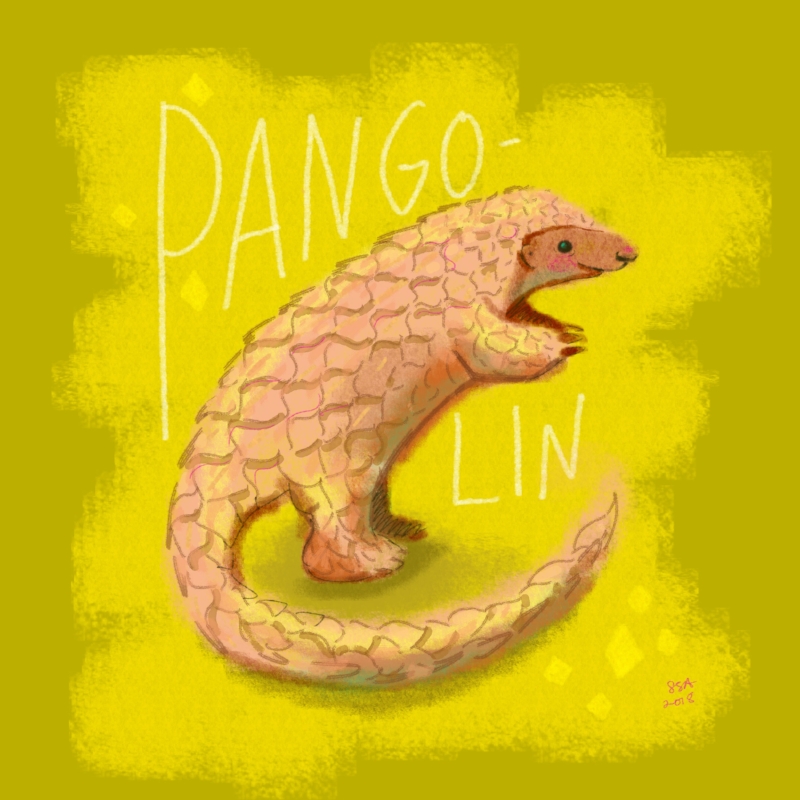10 FACTS ABOUT PANGOLINS
Original Pangolin artwork created by Laurel Scribner Abbott, a graphic designer with the Walt Disney Imagineers.
Have you heard of the pangolin? Here's ten facts about Pangolins that we think are important to share as the world gives Pangolins a big awareness-raising media hug for World Pangolin Day.
1. Pangolins are the only mammals covered in scales. Their large, hard, overlapping scales make them look like a pine cone. Even the teeth of lions can't penetrate their body armor. To protect itself from danger, the pangolin rolls up into a ball - which is how it got its name: "Pangolin" comes from the Malay word 'penggulung' which means 'one that rolls up'.
Scales of the Temminck's ground pangolin, the only type of pangolin found in South Africa. Photo Credit: Luke Massey/WildScreen Exchange.
2. Pangolins are the most trafficked mammal in the world. It has been conservatively estimated that over 1.1 million pangolins have been poached for the illegal trade in the last 16 years. Their scales and body parts are used in traditional medicine, bushmeat and for demand in Asian markets where they are eaten as a delicacy and for use in traditional medicine. It is unknown how many remain in the wild. All international trade in pangolins was banned by at the CITES CoP17 conference in October 2016, taking effect on January 2, 2017. This enables law enforcement around the world to increase domestic protections to fight the tremendous threats facing the species.
3. Did you know that after China, the United States is the largest destination for trafficked pangolins? In a report published by TRAFFIC and the International Union for the Conservation of Nature (IUCN) in December 2017, China and the US were identified as the most common destinations for international pangolin trafficking during the period studied (2010-2015). Shipments of pangolin parts are arriving in the US from Asian countries - directly from China and Vietnam and also Mexico.
4. There are both Asian and African pangolin species. Four of each. In Africa, the four pangolin species are:
Tree or African white-bellied pangolin (Phataginus tricuspis - Vulnerable),
Giant ground pangolin (Smutsia gigantea - Vulnerable),
Cape or Temminick's ground pangolin (Manis temminickii - Vulnerable) and the
Long-tailed or black-bellied pangolin (Uromanis tetradactyla - Vulnerable)
5. Pangolins are native in 15 African countries where its predators are leopards, hyenas and humans. In South Africa, electric fences are a major threat to ground pangolins. The shock of the fence causes the pangolin to roll up into its defensive ball, which prolongs the shock causing death (the mortality rate due to electric fencing is estimated at 2~13% of their total population each year).
African ground pangolins and solitary and nocturnal - here's one at night, on the move. Photo Credit: Luke Massey/WildScreen Exchange
6. The only species of pangolin found in South Africa is the ground pangolin also known as Temminick's ground pangolin or the Cape pangolin. The Temminick ground pangolin looks a bit like a mini T-Rex when it walks. It curls up its front claws and walks on its knuckles or wrists, with its head swaying from side to side. They are also surprisingly good swimmers, and like to live near a water source. They are an amazing sight for those lucky enough to see one in the wild - a very rare sighting!
7. African ground pangolins prefer their own company, living mostly solitary and nocturnal lives. Males and females find each other during mating season which takes place in late summer to early autumn.
8. African pangolins give birth to a single baby pangolin at a time whereas the Asian species have been known to give birth to litters of up to three. When born, the baby pangolin scales are soft, taking several days to harden and darken. If the Mother pangolin senses danger, she will wrap her body around her baby to protect it. Baby pangolins are weaned at approximately three months and begin to eat insects on their own. Once they turn two years old, they leave they are abandoned by their mother.
9. Pangolins eat a LOT of ants, termites and other insects. Up to 200,000 each and every day. That means a single pangolin can eat 70 million insects in a single year! They are a natural form of insect control and an important part of a healthy ecosystem.
Pangolins, snakes and monitor lizards in cages at an Illicit endangered wildlife restaurant (location undisclosed, Asia). Photo Credit: Soggydan Benenovitch/WildScreen Exchange.
10. The biggest threat to pangolins globally today is the illegal wildlife trade. African species are largely hunted locally as bushmeat but increasingly are at risk from poachers who traffic them illegally to Asia. The illegal trade in wildlife has been linked to terrorism, a source of hard currency for militias, terrorist groups and rouge states including North Korea.
Help us to help pangolins! Donate to support our efforts!
Given the shy, reclusive nature of pangolins, we are not sure if and where they still exist in the wild in our region (KwaZulu-Natal South Africa). This is important information that is needed to guide a recovery plan. Wild Tomorrow Fund plans to survey local community members, rangers, farmers and conservation managers working at or near regional wildlife reserves to review the status of pangolins in northern Zululand.
Armed with this knowledge, we can better understand future conservation options and plans for pangolins in northern KwaZulu-Natal. We have already identified potential future release sites for poached pangolins and are working with a local technology partner to create a pangolin-sized tracker to monitor them once released back into the wild. We also provide funding for intelligence-led investigative work by local wildlife law enforcement which is critical to identifying poached pangolins that are still alive in captivity before they are trafficked.




